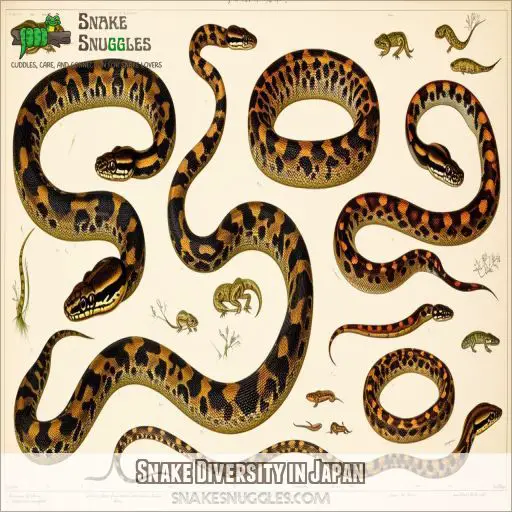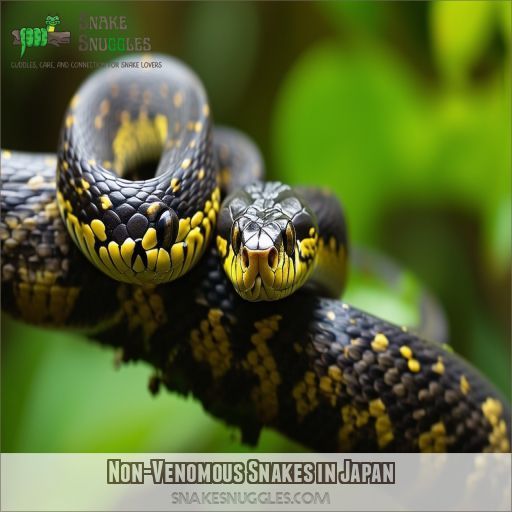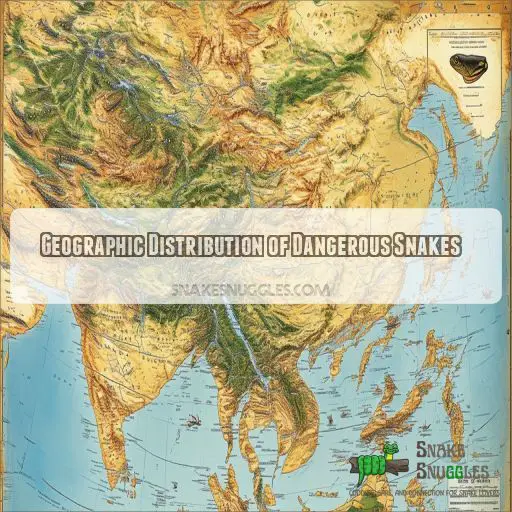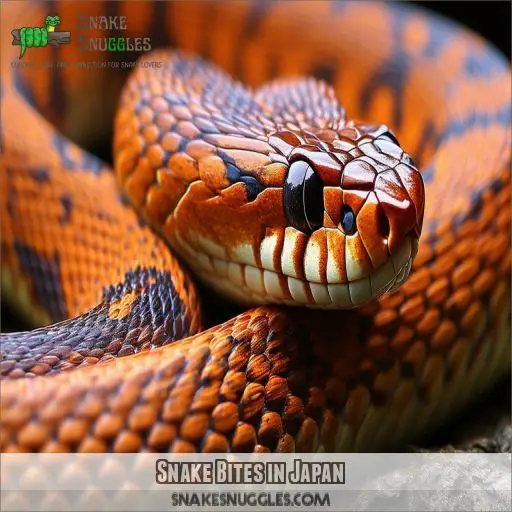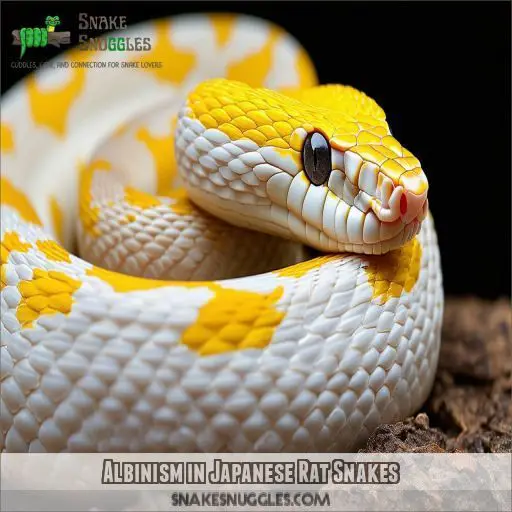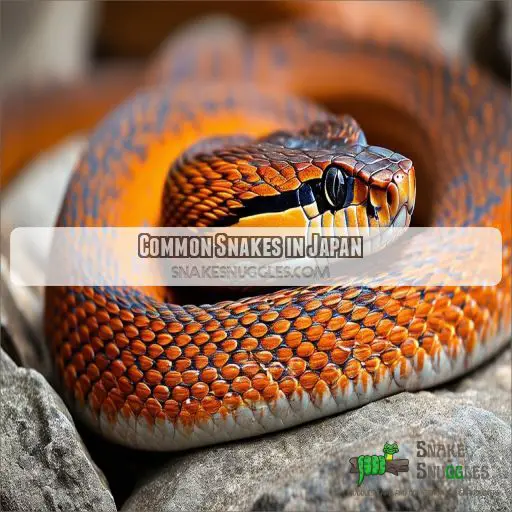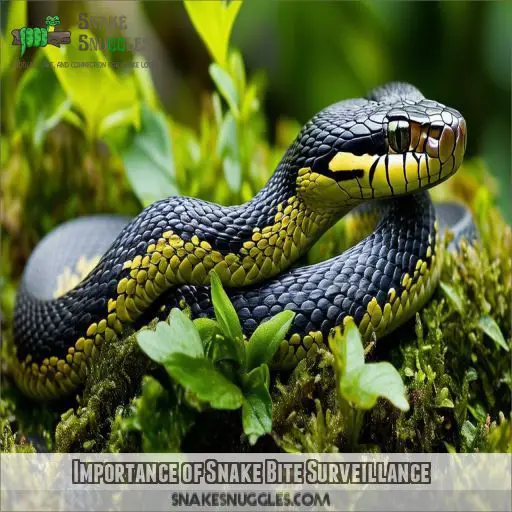This site is supported by our readers. We may earn a commission, at no cost to you, if you purchase through links.

Table Of Contents
- Key Takeaways
- Are There Snakes in Japan?
- Snake Diversity in Japan
- Non-Venomous Snakes in Japan
- Characteristics of Harmless Snakes
- Venomous Snakes in Japan
- Geographic Distribution of Dangerous Snakes
- Snake Bites in Japan
- Albinism in Japanese Rat Snakes
- Common Snakes in Japan
- Dangerous Snakes in Japan
- Importance of Snake Bite Surveillance
- Frequently Asked Questions (FAQs)
- Are there any dangerous snakes in Japan?
- Are there big snakes in Japan?
- Which country is known for not having any snakes?
- What country has most snakes?
- How do Japanese people view snakes culturally?
- Can you find snake-related souvenirs in Japan?
- What precautions should hikers take against snakes?
- Are there snakes in urban areas of Japan?
- What months are snakes most active in Japan?
- Conclusion
Key Takeaways
Japan is a land of contrasts, and its snake population is no exception. From the harmless Japanese Rat Snake to the deadly Mamushi Pit Viper, there’s a snake for every taste.
If you’re planning on hiking in Japan, be sure to wear appropriate clothing and footwear, and be aware of your surroundings. Snakes are most active during the warmer months, so it’s important to take precautions.
If you’re bitten by a snake, don’t panic. Seek medical attention immediately. The sooner you get treatment, the better your chances of a full recovery.
Snakes are a part of the Japanese ecosystem, and they play an important role in the food chain. By learning more about snakes, we can better appreciate their role in the natural world.
Are There Snakes in Japan?
Yes, Japan does have some snakes. There are 47 species distributed in different habitats ranging from forests to cities.
Some non-poisonous varieties include the Japanese Rat Snake, which is very common in gardens, while the Japanese Striped Snake and Jimguri stand out due to clear markings.
On the dangerous side, there is the Mamushi Pit Viper and Okinawa’s Habu, both with high-intensity venom.
Snake bites are uncommon, with approximately 1,670 cases seen in six months from 404 hospitals; however, older adults tend to be primarily affected.
Are you curious about the different types and their habits? Let’s get more details.
Snake Diversity in Japan
Japan’s snake diversity is quite remarkable, with 47 species inhabiting various ecological habitats across the country. You’ll find both venomous and nonvenomous snakes filling unique niches, from dense forests to bustling urban areas.
The Ryukyu archipelago, in particular, harbors species underscoring this diversity, although invasive species like mongooses threaten some indigenous reptiles. This region’s snakes exhibit fascinating adaptations, enhancing their survival in different environments. Unfortunately, some areas face ecological imbalances due to these invasive threats.
Despite these challenges, Japan’s snake population, characterized by such variety, reflects a resilient, intricately balanced ecosystem, though vigilance is required to maintain its health and diversity. These dynamic interactions showcase the rich, diverse tapestry of Japan’s vibrant snake life.
Non-Venomous Snakes in Japan
After exploring the diverse snake population in Japan, let’s shift our focus to non-venomous snakes you’ll often find in the region. These harmless species play an essential role in the ecosystem, ensuring a balanced environment.
You might encounter:
- Japanese Rat Snake: Common throughout Japan, including a unique albino population in Iwakuni City.
- Japanese Striped Snake: Recognized by its yellow or light brown color with four distinctive stripes.
- Jimguri: A reddish-brown snake with small black splotches, often found in various habitats.
- Japanese Keelback: Small and usually light brown, it’s non-poisonous but sometimes mistaken for venomous snakes.
- Green Grass Lizards: Though not a snake, these reptiles share habitats with many Japanese snakes, adding to the biodiversity.
Understanding these non-venomous snakes helps promote snake ecology, conservation, and awareness.
Characteristics of Harmless Snakes
In the search for snakes in Japan, one finds a wide array of non-venomous species that seem to do well in all ecological settings. Those innocuous ones, like Japanese rat snakes and Japanese striped snakes, are so common as to mean no danger to the people.
The Japanese rat snakes are exceptional not only for their size but also because they’re known to be gentle; an albino population exists in Iwakuni City. Such snakes fulfill essential functions related to rodent control.
Unfortunately, many of these non-venomous species are under threat as a result of habitat destruction and other human activities, although conservation efforts are currently underway to protect them. Some traditional beliefs view these snakes as good omen-endowed, a belief that brings particular cultural affinity.
Knowing their characteristics emphasizes the need they get to Japan’s ecosystem.
Venomous Snakes in Japan
Japan hosts several venomous snakes, most significantly the Mamushi Pit Viper and Japanese Habu; both pose significant hazards because of their high human exposure and the degree of toxicity.
Mamushi Pit Viper
The Mamushi pit viper is Japan’s most dangerous snake. It uses heat-sensitive glands to hunt and can bite when startled.
- Habitat: Found throughout Japan
- Venom Effect: Causes tissue liquefaction
- Treatment: Intensive hospital care required, typically a week
- Prevention: Avoidance and proper footwear in snake-prone areas
Japanese Habu
The Japanese Habu is another notable venomous snake, primarily found on Okinawa Islands. Known for its light olive or brown color with dark blotches, it resides in woods, palm fields, and caves. At up to 225 centimeters, it poses a significant bite risk. Conservation efforts aim to protect its habitat amid increasing human encroachment and habitat destruction.
Geographic Distribution of Dangerous Snakes
Knowing where dangerous snakes, such as mamushi and habu, are found is very important in any safety and preventive measure. Geographically, their distribution varies across Japan:
- Mamushi Habitat: These snakes are found to occur between latitudes 30°N and 46°N, pollution the southern parts of Japan. The larger populations in Okinawa and Sakishima Islands are attributed to better temperatures.
- Habu Snakes: These inhabit the Okinawa Islands and live in woods, palm fields, and caves for the most part.
- Regional Snake Populations: Overall, in Japan, snakes are living in such different habitats as sea-coast areas, dense forests, etc. Knowing the regions of habitation of venomous snakes frequently helps in assessing the risk level and raising snake-bite prevention measures. This understanding facilitates meticulous snake venom research and treatment of snake bites in time.
Snake Bites in Japan
Snake bites in Japan are a significant public health issue, with particular attention to the dangerous Mamushi pit viper. It’s essential to understand the epidemiology, clinical manifestations, and geographic distribution of these bites to effectively manage and prevent them.
Epidemiology of Snake Bites
In Japan, the epidemiology of snake bites shows 1,670 inpatients from 404 hospitals in a half-year period.
The average age of the victims is 60.1 years, with the mortality rate being less than 0.2%.
Problems anticipated include hypovolemic shock and issues with the need for fasciotomy.
Both venomous and harmless snakes are responsible for this number of hospitalizations; thus, there must be a way of reporting comprehensively so that appropriate prevention can be taken.
Clinical Manifestations of Snake Bites
Envenoming by venomous snakes in Japan may result in severe clinical manifestations, which may include compartment syndrome that may require fasciotomy, hypovolemic shock, acute kidney injury, and disseminated intravascular coagulation. Thus, it’s essential to be aware of both venomous and non-venomous snakes to promptly attend to medical treatment for mitigating life-threatening conditions and ensuring recovery from envenoming.
Geographic Distribution of Mamushi Bites
Mamushi bites in Japan occur mostly between latitudes 30°N and 46°N, with higher incidence in southern regions, especially Okinawa and Sakishima islands. Temperature influences their distribution. Most bites occur unexpectedly, often when you stumble upon one. Effective mamushi bite treatment and prevention measures are essential due to the snake’s widespread presence and potential danger.
Albinism in Japanese Rat Snakes
Japanese rat snakes are non-venomous and common throughout Japan, distinguished by their impressive size and docile nature. In Iwakuni City, a unique population exhibits albinism, a genetic condition causing a lack of pigment. These albino snakes, often pure white with striking red eyes, are a rare natural marvel among the snakes in Japan.
Conservation efforts focus on protecting these albino Japanese rat snakes due to their limited habitat and vulnerability. Ethical considerations include minimizing human disturbance and habitat destruction to preserve these unique genetic traits. Understanding and protecting this population enhances biodiversity and supports broader ecological efforts within the region.
Common Snakes in Japan
When studying snakes in Japan, you’ll discover a rather interesting variety of common species. The nonpoisonous Japanese Rat Snake isn’t known to be dangerous and reaches as much as 7 feet; it’s most often present in gardens.
Japanese Striped Snakes are yellow or light brown with body-length strips. Another harmless species is the little Jimguri, colored reddish-brown and dotted with black blotches. The harmless Japanese Keelback flattens its neck, mimicking the more dangerous snakes, as a defense mechanism.
Another exciting factor about the dark brown or olive Yamakagashi is that it attains its toxicity from the poisonous frogs. All these ordinary snakes represent different ecological niches and thereby serve to enrich Japan’s biodiversity. Of the various species mentioned here, a few—such as the Japanese Rat Snake—are found with localized populations having albinism.
Dangerous Snakes in Japan
Now, some dangerous snakes in Japan:
Mamushi pit viper is viewed as the most feared venomous snake in Japan and bites 2,000 to 4,000 people yearly. Its poison causes severe tissue damage and requires intensive hospital care.
Habu occurs on the Okinawa Islands and presents significant threats due to its potent venom in the rural areas.
With all the dangers, snake bites are survivable if treated promptly. Any person entering these territories should know the availability of antivenom and guidelines for snake bite treatment.
You can minimize encounters by avoiding long grass, using a flashlight at night, and learning which areas they frequent. Principles of wisdom in being cautious and aware are simply your best defenses.
Take pleasure in Japan’s rich variety of both venomous and harmless snakes while keeping yourself safe and informed.
Importance of Snake Bite Surveillance
Snakebite surveillance is essential. Japan is home to some poisonous and non-poisonous species that cause serious health problems. Epidemiological data shows severe gaps; without a sound reporting system, the real burden of disease remains unknown.
Good surveillance will help establish effective preventive measures against snakebite encephalitis and pinpoint high-risk areas for prompt medical response. Adequately designed and population-based systems anchor full capture of snakebites for timely treatment with reduced fatalities in snakebite management.
Healthcare providers will, in turn, be able to improve the management of snakebites continuously for community safety by monitoring trends. If the impact of snakebites has to be reduced across Japan, then deal with it as a public health problem through consistent data collection.
Frequently Asked Questions (FAQs)
Are there any dangerous snakes in Japan?
Yes, Japan has dangerous snakes. The Japanese Mamushi and Habu are the most venomous. The Mamushi’s bite can liquefy tissue, while the Habu is found mainly on the Okinawa Islands and has a high incidence of bites.
Are there big snakes in Japan?
You will find giant snakes in Japan, like the Japanese Rat Snake, which reaches as long as 5 meters, and the Japanese Keelback. While non-poisonous, they’re pretty big and, therefore form one of the many attractions for nature lovers.
Which country is known for not having any snakes?
Ireland is known for not having any native snakes. According to legend, Saint Patrick drove them away; however, scientific explanations suggest that snakes never colonized Ireland after the last Ice Age due to the cold climate and isolation.
What country has most snakes?
Australia’s teeming with snakes! It boasts the most snake species globally due to its diverse habitats—ranging from deserts to rainforests. The country is home to many venomous species, including the infamous inland taipan.
How do Japanese people view snakes culturally?
In Japan, snakes are often viewed with a mix of reverence and superstition, symbolizing both danger and protection. The white Japanese rat snake, especially, is considered a sacred creature, bringing good fortune and prosperity.
Can you find snake-related souvenirs in Japan?
You can find snake-related souvenirs in Japan, such as snake-themed keychains, plush toys, and even snake-patterned textiles. Specialty shops and tourist spots often sell these items, reflecting Japan’s unique fascination with these reptiles.
What precautions should hikers take against snakes?
An ounce of prevention is worth a pound of cure. Wear boots, long pants, and stay on trails. Be cautious near rocks and underbrush. Carry a snakebite kit and know the location of the nearest medical facility.
Are there snakes in urban areas of Japan?
Yes, snakes can be found in urban areas of Japan. While it’s less common, species like the nonvenomous Japanese Rat Snake and the venomous Mamushi have been known to inhabit gardens, parks, and residential spaces.
What months are snakes most active in Japan?
Snakes in Japan are most active from April to October. During these warmer months, their activity peaks due to favorable temperatures, making it essential to stay cautious, especially in regions where venomous species like the mamushi are prevalent.
Conclusion
Nearly 47 species of snakes inhabit Japan, so knowing which are venomous could be a decision between life and death.
You’ll come across several regions with both non-venomous and venomous snakes, including Mamushi Pit Viper and Japanese Habu.
Attention should, therefore, be noted to the geographic distribution and epidemiology of snake bites at all times.
Be informed about the albinism in snakes and some common species that would enlighten you on your awareness.

